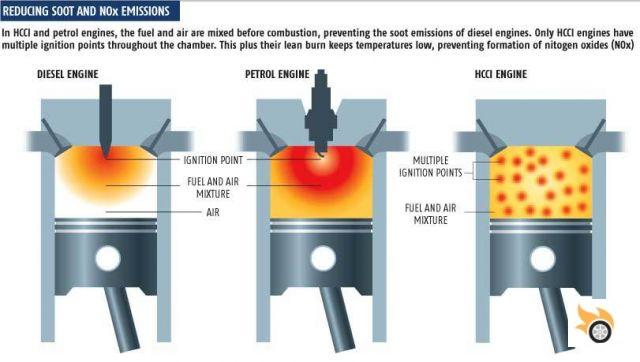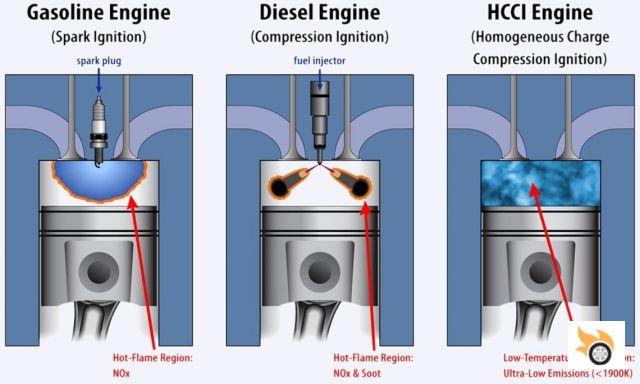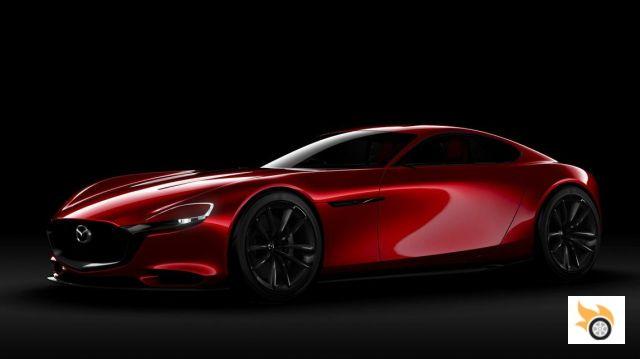After direct injection, turbochargers and intercoolers, the next step will be to use the compression of the gasoline, and not the spark provided by a spark plug, to ignite the gasoline in the combustion chamber. This is a topic we've visited a couple of times in the past, but today, we'll look at it in detail. It is one of the last moves of the internal combustion engine before passing the baton definitively to other technologies.
To explain how spark plug-less ignition works, we'll first take a quick look at the combustion stage in the Otto cycle, where the mixture is ignited by the spark plugs:
Of the four stages into which the Otto cycle is divided: intake, compression, explosion and exhaust, only the explosion stage applies force (kinetic energy) to the rotation of the crankshaft. This force, in turn, is "stored" in the flywheel, to which the gearbox is connected through the clutch.
In a conventional petrol engine, the explosion phase occurs after compression, when the piston rises from bottom dead centre (BDC) to top dead centre (TDC), compressing the air/petrol mixture as it passes through. Once the PMS is reached, the distributor (delco pipe), supplies 5,000 V to the cylinder in question so that the spark plug produces a spark that ignites the mixture, producing a flame front that consumes the same, pushing the piston to PMI. The mixture does not always ignite at PMI, it depends on the ignition advance: a retarded one warms up the engine, an advanced one generates more power.
Over the years, this basic premise has been complicated by technical advances. From a bird's eye view, it may seem that the only changes have been from carburetion to indirect injection, and from indirect to direct injection. But in reality, there have been many, many smaller advances that are not often talked about, such as improvements in the design of the combustion chamber, improvements in the materials used that facilitate heat dissipation, or improvements in how the jet of gasoline is injected into the cylinder (a more homogeneous mixture facilitates a consistent advance of the flame front), among many others.
What are the limits we are facing?
Most manufacturers, following the downsizing trend, have advocated abandoning naturally aspirated engines and opting for turbochargers, which increase engine efficiency by introducing compressed air into the combustion chamber: more air means more petrol can be burned, and more power can be obtained in the explosion phase. But as the mixture of air and petrol takes more pressure inside the combustion chamber, the temperature to which the mixture is subjected inside the chamber increases, increasing the chances of the mixture self-detonating on its own, before the flame front produced by the ignition of the spark plug consumes it; this is why the compression ratio in turbo engines is relatively low, to protect us from self-detonation.
Recall that self-detonation, or crank pitting, is not a premature detonation of the gasoline mixture before the piston reaches the upper midpoint, but a second or third detonation, after ignition of the mixture by the spark plug. As the flame front advances consuming the mixture, the pressure and temperature in the unconsumed gasoline-air mixture rises, and if the flame front does not arrive in time, it can self-detonate, causing the new flame front to reach the cylinder walls (which does not happen in a controlled ignition), and can also break the thermal protection layer that prevents the burning mixture from melting the metal of the piston and the cylinder head gasket. On the other hand, when the mixture burns prematurely, before the end of the compression stroke and the spark plug discharges, we speak of pre-ignition, not self-ignition.
The higher octane rating of gasoline prevents self-ignition, as it offers more resistance to uncontrolled burning. With low octane ratings, low compression ratios must be used, which is why older engines gave such low specific power outputs.
When ignition is initiated by a spark plug, combustion is centred in the area of the chamber around the spark, so the flame front does not advance evenly, leaving unconsumed residues, even if the air-gasoline mixture is stoichiometric. The high temperatures at which the deflagration takes place inside the cylinder favour not only the appearance of nitrogen oxides (NOx), which contribute to the pollution of our air and increase the chances of acid rain, but also the (I hope) already famous soot microparticles, so small that we can breathe them and that, after being deposited in our lungs, can cause cancer.

Lean burn combustion combustion comes into the picture
You may be more familiar with HCCI, or Homogeneous Charged Compression Ignition. The basic idea is to achieve a higher compression ratio through controlled self-detonation of the air-gasoline mixture in the combustion chamber, without the use of a spark plug.
How does it work?
The first problem faced by manufacturers is the word "homogeneous" in the alphabet soup that is the acronym HCCI, because the air-gasoline cocktail must be well mixed for combustion to be effective and leave no residue. In the case of spark plug ignition, a good mixture is also important, but as the ignition is concentrated in the area closest to the spark plug, it is less important.
If we have achieved a perfectly homogeneous mixture of air and gasoline, when the compression stroke ends, the pressure and temperature inside the combustion chamber will cause ignition to occur at various points in the mixture, consuming it completely and evenly, leaving no residue. Because the combustion has occurred homogeneously and simultaneously, there is no flame front at a very high temperature, as it does in the case of spark plug combustion.

What does this mean? Well, combustion by lean-burn ignition is, in some cases, up to 500 ºC cooler than spark ignition combustion, not even exceeding 1500 ºC. And as a result of this less calorific deflagration, no nitrogen oxides are produced during the explosion phase. In addition, carcinogenic soot microparticles are not produced, and carbon oxide emissions are also significantly reduced. On top of that, there are fewer energy losses due to less heat transfer (there is less heat to transfer), so there is a gain in energy efficiency.
How much compression are we talking about?
On the order of 18:1, very high for a gasoline engine, Mazda SKYACTIV-Gs work at 14:1, the highest compression ratio in the industry. And since we are adding more air than is needed to consume one part of gasoline (remember that an ideal stoichiometric mixture corresponds to a ratio of 14.7:1), we say that the mixture is lean, because there is more air than can be burned per drop of gasoline. In a rich mixture the opposite happens: there is more petrol than can be burnt with the air in the cylinder, so that at the end of combustion, there will be unburnt petrol left over or it will come out through the exhaust valves.
Why no uncontrolled self-detonation occurs in this case?
Because the mixture is homogeneous and compression combustion occurs in several parts of the chamber simultaneously, there are no regions within the combustion chamber with different pressure levels, so there is no danger of self-detonation, except when the engine is running at full load. Therefore, the lean mixture compression ignition strategy is intended to be applied when the engine is at low or partial load, requiring spark plug combustion at specific times. This means that spark plug manufacturers will still be able to earn a living, but users with engines of this type will not need as many replacements as they will use them much less.
How new is this idea?
Automotive history is vast, rich and very long, and while there aren't many precedents for lean-burn compression ignition, there are plenty of past examples where engineers took inspiration from diesel engines to try to reduce emissions from their gasoline engines.
In the 1970s, Honda introduced the CVCC (Compound Vortex Controlled Combustion) concept, the premise of which copied the then diesel concept of combustion in an antechamber. This technique allowed Honda to meet emissions regulations in both Japan and the United States during the 1970s without the need for a catalytic converter or EGR (Exhaust Gas Recirculation) valve. In addition, this invention allowed Honda to continue using carburetors, unlike other mixture leaning systems known at the time, which required expensive injection systems.
How did they achieve this?
As in compression combustion, the air-gasoline mixture in the cylinder was lean, but the mixture in the antechamber was rich. On ignition, the flame front is born in the antechamber, and propagates through small holes in the metal plate separating the antechamber from the cylinder, allowing the flame front to reach the lean mixture in the cylinder and consume it completely, with consequent reductions in carbon monoxide emissions.
General Motors doubted the effectiveness of this system and mocked Honda, saying it was only suitable for small cars. The Japanese company hit back by buying a large American car, a 1973 Chevrolet Impala 5.7 V8, sending it to Japan, retrofitting the CVCC system and sending it back to the U.S. for homologation. The EPA certified that the Civic's system was also valid for a thirsty American V8.
Toyota obtained a license to use this system in 1975, under the trade name TTC-V (Toyota Total Clean system-Vortex), and after making its own modifications and launching it commercially in 1976, discontinued its use in 1977, to then use it again in certain vehicles of the Daihatsu brand. Honda would use this technology for approximately ten years, from 1975 to 1986, until it was abandoned to make way for the use of fuel injection systems.
And... anything more recent that is in use today?
Having seen the energy efficiency benefits of HCCI technology, and how far ahead Mercedes were in all areas as they entered the V6 Turbo era in Formula 1, there was speculation that Brixworth (not to be confused with Brackley, which is where the chassis are made), were using this technique in their engines. With the addition of MAHLE as Ferrari's sponsor at the 2015 Canadian Grand Prix, and the Italians' use of engine modification tokens during that same event, it was believed that the Maranello outfit had also adopted lean-burn compression ignition.
However, these rumours were denied because HCCI would require the use of variable timing systems in order to revert to conventional combustion at full load, and variable timing is prohibited by the current regulations. Finally, it was discovered that Brixworth and Maranello are using turbulent jet ignition, better known as TJI or Turbulent Jet Ignition.
Another big reason why it was believed that Mercedes might be using HCCI in Formula 1 is because they have been promoting it for years as a feature of their DiesOtto engine concept, which, again, tries to apply the best concepts from diesel engines and bring them to petrol engines. It was introduced in 2007 in the form of a 1.8-litre 4-cylinder, putting out 235 hp (130 hp/litre) and 400 Nm of torque, with gasoline direct injection, two variable geometry turbos, variable compression ratio, variable timing, and of course, lean mixture compression ignition or HCCI. According to Mercedes, the variable compression ratio is a requirement in order to reap the full benefits of direct injection and twin turbos at high engine load when HCCI is not being employed.
We haven't heard from them since 2014.
But they are not the only ones eager to introduce HCCI technology in our engines. General Motors announced in 2009 the development of four-cylinder engines with lean-mix compression ignition, but they have not yet been able to apply it to commercial engines. What they have done is to use the knowledge derived from their development and research in the updated ECOTEC modular engine family, which we can see in the Opel range on this side of the pond. And in South Korea Hyundai is developing its own engine with HCCI, called GDCI or Gasoline Direct Compression Ignition, with the difference that they intend not to use spark plugs in any case, not even when the engine is at full load. To avoid self-detonation, a mixture of cold air is compressed with hot air from the exhaust manifold (up to 40%), and the fuel injection is delayed until the piston reaches PMS in the compression stroke, thus maximizing the explosion stroke.
But who we really trust to bring this technology to the market is none other than Mazda, because with its SKYACTIV technology, Mazda has bet its future on doing something different (something very Mazda, of course), and that is to oppose downsizing and focus on pursuing the highest possible efficiency in its naturally aspirated engines that, having larger displacements than the competition, have real consumption much closer to those declared than their supercharged rivals, the rightsizing.
Ironies of life, now Mazda defends the saying "There's no replacement for displacement".
We already know the current SKYACTIV generation, so what's in store for the next one? As Guille already told us, Mazda expects to be able to increase its compression ratio much more, using HCCI, drastically improving the efficiency levels of its engines.
But that's not all, because lean-mix compression ignition may also make its way to Wankel-type engines, and not only to the SKYACTIV-R engine of the future RX-9 (which we expect in 2020), but also in other smaller rotary engines that Mazda intends to use as range extenders to charge the batteries of its electric vehicles. In addition to its reduced weight and dimensions, if we compare the noise produced at 3,000 RPM, the piston extender produces 92 dB, while Mazda's rotary engine produces 87 dB: almost four times less noise (remember that decibels are measured on a logarithmic scale).
So what does this mean? It means that the user whose vehicle has a rotary range extender won't hear a thing when it starts up.
Admittedly, this is not our idyllic scenario for a rotary engine, but anything that makes it more useful and increases the likelihood of its use becoming more widespread is a plus, in my opinion.
Conclusions
It may seem new to us - stealing ideas from diesel engines to improve our petrol engines - but the reality is that manufacturers have been trying to bring petrol engine techniques to our petrol cars for years. For example, downsizing isn't new either; if you look at this page from Popular Mechanics magazine's December 1979 issue, you can read how GM and Chrysler were opting to install more four- and six-cylinder engines in place of their V8s due to fuel economy requirements from the US government, and how Ford, with its PROCO (PROgrammed COmbustion) engine concept, planned to keep its V8s on the market and resist the fad of the moment. If history is cyclical...

Steve used to say that "a good artist copies, [but] great artists steal". Let's see if gasoline engines manage to steal compression ignition from petrol engines.

























